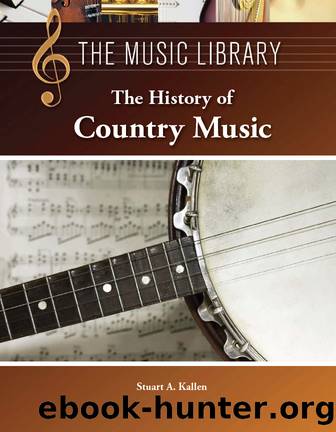The History of Country Music by Kallen Stuart A.;

Author:Kallen, Stuart A.;
Language: eng
Format: epub
Tags: The History of American Pop
ISBN: 5538499
Publisher: Greenhaven Publishing LLC
Published: 2018-07-02T00:00:00+00:00
CHAPTER 5
Country Rock and Outlaws
In the second half of the 1960s Nashville, Tennessee, was known as the country music capital of the world. The people who worked in the cityâs music industry were also known for promoting conservative political, religious, and social values. To many in Nashville during this era, it seemed as if people in the rest of the country were losing their minds. Beginning around 1966, millions of young people, especially in California and northern cities, began experimenting with marijuana and LSD (lysergic acid diethylamide, or acid). This spawned a period of social upheaval that became known as the counterculture, or hippie movement. Hippies rejected traditional beliefs about politics, sex, and religion. They adopted their own slang and fashions, which included long hair and beards on men, tiedyed shirts, blue jeans, sandals, and love beads.
Many Nashville residents expressed open contempt for the counterculture. When singer Joni Mitchell visited the city in the late sixties, accompanied by an entourage of West Coast male musicians, she recalled âeverybody was hostile to them. People yelled, called them shaggy-hairs and hippies. They felt unsafe.â39 The hippies, in turn, called country music fans rednecks, a derogatory term that had replaced hillbilly by the 1960s.
Given this hostile environment, many were surprised when Bob Dylan released the album John Wesley Harding in 1967. Recorded in Nashville, the album combined Dylanâs trademark storytelling lyrics with simple country music. By this time Dylan was one of the most famous singers in the world. He achieved fame in 1963 for protest songs, which addressed issues such as racial inequality, nuclear fallout, and the bomb builders he called masters of war. In 1964 Dylan abandoned what he termed âfinger-pointing songsâ40 that made political statements and began writing long epics. Today these influential songs from the mid-1960s, such as âMr. Tambourine Man,â âGates of Eden,â âJust Like a Woman,â âVisions Of Johanna,â and âLike a Rolling Stone,â are considered timeless classics.
Dylanâs music made him a hero of the counterculture movement, but his roots were in country music. He was around ten years old in 1951 when he heard Hank Williams on the Grand Ole Opry radio show. As he wrote in his 2004 autobiography, âThe first time I heard Hank . . . [the] sound of his voice went through me like an electric rod and I managed to get a hold of a few of his [records] . . . and I played them endlessly.â41
The album John Wesley Harding appeared during the height of the hippie era. At this time, many rock musicians were experimenting with the psychedelic drug LSD, which inspired them to create some of the most influential music of the twentieth century. In 1967 rock artists such as Jimi Hendrix, the Grateful Dead, the Beatles, and the Rolling Stones recorded dense musical masterpieces filled with swirling, cascading guitar licks, undulating drums, sound effects, and studio tricks. Dylanâs influence was so powerful, however, that the bare country textures of John Wesley Harding prompted the Beatles and other top acts to abandon their overproduced sound in an attempt to echo Dylanâs musical simplicity.
Download
This site does not store any files on its server. We only index and link to content provided by other sites. Please contact the content providers to delete copyright contents if any and email us, we'll remove relevant links or contents immediately.
Audition by Ryu Murakami(4756)
The House on Mango Street by Sandra Cisneros(3342)
Draw-A-Saurus by James Silvani(2598)
Dork Diaries 12 by Rachel Renée Russell(2292)
Born Out of Wedlock by Lyn Gardner(2152)
Frankly, Frannie by AJ Stern(2133)
Miss Peregrine's Home for Peculiar Children by Ransom Riggs(2130)
The Audition by Maddie Ziegler(2110)
Origami Art by Michael G. Lafosse & Richard L. Alexander(2029)
Yerma by Federico García Lorca(1975)
I Know Why the Caged Bird Sings by Maya Angelou(1940)
Sophie's World by Jostein Gaarder(1927)
1936941139 (N) by Bob Rosenthal(1800)
Fashion 101 by Erika Stalder(1743)
I know why the caged bird sings by Maya Angelou(1681)
Hamnet by Maggie O'Farrell(1636)
Romancing the Nerd by Leah Rae Miller(1614)
Being Nikki by Meg Cabot(1566)
Star-Crossed by Barbara Dee(1524)
